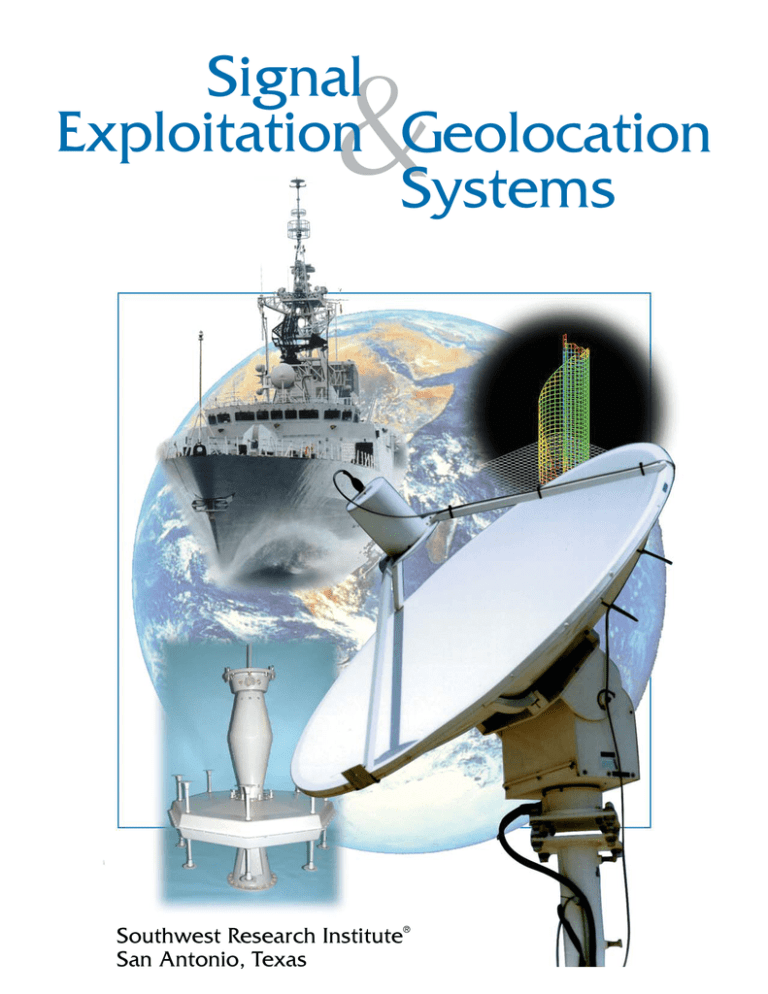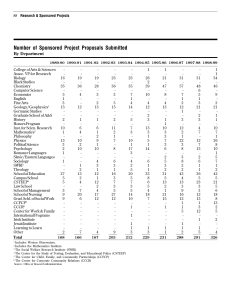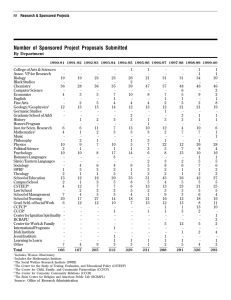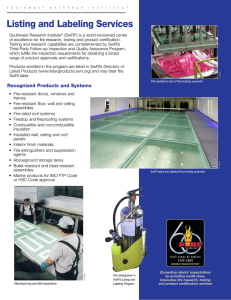Signal Exploitation and Geolocation Systems
advertisement

Signal Exploitation Geolocation Systems Southwest Research Institute® San Antonio, Texas 5 Signal Exploitation and Geolocation Systems ©2006 Southwest Research Institute. All rights reserved. An Equal Opportunity Employer M/F/D/V Committed to Diversity in the Workplace Photos on cover courtesy of U.S. Army, U.S. Navy, and the Canadian Navy. E111002 S Photos courtesy of U.S. Navy outhwest Research Institute (SwRI) is recognized worldwide as a leader in radio-frequency (RF) signal exploitation and geolocation system development. The Institute provides advanced acquisition, recognition, direction finding (DF), surveillance, and tracking systems to government agencies, militaries, and commercial clients in the United States and around the world. SwRI provides a wide range of systems and technical support in: Signal acquisition, intercept, and recognition 䡵 Tactical intelligence systems 䡵 Naval communications intelligence systems 䡵 Ground-based DF and single-site location systems 䡵 Battlespace instrumentation 䡵 Portable DF systems 䡵 Spectrum surveillance systems 䡵 Worldwide tracking via satellite 䡵 Combat identification and situational awareness 䡵 Software engineering 䡵 Antennas and propagation 䡵 Analysis, simulation, and testing capabilities 䡵 Logistics and life-cycle support 䡵 Reusable software 䡵 Advanced acoustic and imaging sensor systems D015192 䡵 SwRI has developed a wide range of shipboard signal acquisition and DF equipment for the U.S., United Kingdom, and Canadian navies. SwRI’s SABER system has been deployed with U.S. troops to provide battlefield situational awareness in support of several operational missions. Institute scientists and engineers work directly with clients to provide optimum hardware and software solutions to specific operational problems. SwRI systems range from one-of-a-kind, commerciallevel designs to large-scale, fully documented, deployment-ready production units. D004763 SwRI acquisition, recognition, and DF systems offer state-of-the-art operator-machine interfaces, which include displays for signal identification, geolocation, and DF. D015208 D015210 D015209 Signal Acquisition, Intercept, and Recognition wRI provides narrowband and wideband electronic support (ES) systems using sophisticated highspeed general-purpose processor arrays and distributed digital signal processing algorithms. Automated signal analysis is tailored to meet the threat environment, including: S 䡵 MF-UHF frequency of interest 䡵 Communications modulations 䡵 Short transmission duration 䡵 Special signals, such as directsequence spread spectrum and frequency hop 䡵 IF panoramic display 䡵 Spectrogram display (IF spectrum vs. time) 䡵 Azimuthalgram (azimuth angle of arrival vs. time) 䡵 Waterfall display (RF spectrum vs. time) D004773 To help intercept operators manually identify signals, SwRI systems incorporate state-of-the-art signal analysis displays, such as: An operator uses this display to analyze an ALE control channel exchange, showing signal activity and corresponding direction-of-arrival in real time. D015196 Using commercial off-the- shelf (COTS) hardware, the Institute develops signal processors that provide wideband (up to 10 MHz/ channel) detection, signal recognition, and DF capabilities in the medium, high-, very high-, and ultra high-frequency (MF, HF, VHF, and UHF) ranges. SwRI specializes in custom rackmounted and portable systems. SwRI developed this signal analysis display to accommodate modern signal modulations. 2 Tactical Intelligence Systems leader in communications intelligence (COMINT) technologies, SwRI has produced systems for navies around the world for more than 45 years. SwRI naval systems meet a variety of design requirements and tactical and strategic needs, including: MF, HF, VHF, and UHF acquisition and DF 䡵 HF skywave DF 䡵 Netted operations 䡵 Wideband intercept and DF 䡵 Automated spectrum surveillance and signal recognition SwRI-developed HF wideband collection systems feature software channelization and pooled processing. 䡵 AN/SRS-1 䡵 AN/SRD-503 and 504 䡵 AN/SSQ-120 䡵 Privateer 䡵 COBLU DE120008 SwRI provides intercept and DF systems for naval land-based sites, ships, and submarines. The Institute designs and tests systems to the severe shipboard environment, including shock, vibration, temperature, and electromagnetic interference (EMI). SwRI develops and produces DF antennas and below-decks equipment groups for major shipboard DF programs that include: Photo couresy of U.S. Navy In addition, SwRI develops customized MF/HF/ VHF/UHF shipboard DF systems for special applications. Advanced DF algorithms and calibration data acquisition and reduction software are integral to the SwRI shipboard DF systems, providing high bearing accuracy in the complex ship environment. COTS technology is emphasized on all SwRI communications intelligence systems to provide state-of-the-art, world-class systems at reduced costs. Engineers use innovative ruggedization techniques to adapt COTS technology to the severe naval environment. SwRI designs antennas for multiple shipboard DF applications. Shown are mast-mounted AS-420 (top inset) and AS-145 antennas (bottom inset) mounted on a lower deck. E109746 D015204 䡵 D015207 A 3 Ground-Based DF and SSL Systems wRI designs, develops, installs, and tests both fixed-site and vehicle-mounted ground-based DF systems, DF networks, and single-station location (SSL) systems featuring: HF through UHF operations 䡵 Automatic signal recognition and DF signal confirmation 䡵 Real-time map displays of DF outstation activity at net control 䡵 Geolocation “fix” processing SwRI’s core processor-based HF interferometer DF systems offer propagationlimited DF performance against skywave signals. Adding a vertical incidence sounder to the system permits SSL operation on targets between 50 and 1500 km from the DF site. The SwRI HF DF and SSL interferometer systems offer unique performance options including: 䡵 N-channel MUSIC DF processing 䡵 N-channel null steering co-channel interference reduction 䡵 Frequency-slice DF processing for enhanced sensitivity and productivity 䡵 Target signal confirmation in the DF channel 䡵 Automated check-target operations SwRI-developed HF wideband systems provide automatic signal processing at extremely high new energy alarm (NEA) rates. SwRI scientists integrated this HF-UHF aquisition and DF COMINT suite into a mobile shelter. D015206 䡵 D015134 S D015193 The SwRI core processor provides goniometric and nongoniometric processing of the circularly disposed antenna arrays (CDAA), including the AN/FLR-9, AN/FRD-10, AN/FRD-13, and PUSHER systems. SwRI maintains an advanced DF operations center, including a real-time operational fixed site, and rooftop to support DF system development. 4 Spectrum Surveillance Systems ith the proliferation of electronic information systems, sensitive and proprietary information is increasingly vulnerable to electronic eavesdropping. Since 1973, SwRI has pioneered the design and development of computer-controlled RF spectrum surveillance systems. SwRI systems provide: W 䡵 Automated RF spectrum monitor 䡵 RF communications–Planning and Operations 䡵 Frequency management 䡵 Signal intelligence (SIGINT) 䡵 Electronic support measures 䡵 Building security–Counter-espionage 䡵 Real-time signal analysis with dynamic filtering 䡵 High-speed spectrum displays and histograms 䡵 Wide 8-MHz bandwidth capture and demodulation 䡵 User-defined frequency bands, resolutions, and detection algorithms 䡵 Interactive and unattended task scheduling 䡵 Ultra broad-band operation–DC through microwave using multiple antennas 䡵 Full utilization of digital signal-processing tools 䡵 Multichannel matrix-switched processing the AN/FRD-10 CDAA shown here. 䡵 AM/FM/SSB/PM/FSK/PSK/QAM/TDMA/subcarrier recognition, demodulation, and digital recording 䡵 Multiple digital drop receivers that provide multiple receiver functions 䡵 Voice modulation recognition (speech detection) 䡵 Signal logging of new, active, and authorized signals 䡵 Autocorrelation of signal by spectrum signature E122436C SwRI configures system solutions by tailoring existing hardware and operational software to provide: Specialized Institute-developed hardware and software are integrated with Hewlett-Packard’s E3238S Blackbird to produce a versatile RF signal surveillance system. D004761 SwRI provides core DF processors for 䡵 Spectral occupancy analysis Signal trace snapshots 䡵 Separate director workstation for control and analysis Engineers use specialized RF signal algorithms and sophisticated hardware to create a histogram of target signals in a signal search for communications monitoring. E70236 䡵 SwRI developed this broadband antenna and radome to be used over the 100 kHz to 10 GHz frequency band. 5 Combat Identification and Situational Awareness wRI designs, develops, and prototypes advanced combat identification and situational awareness equipment for the digitized battlefield. Institute engineers have developed a cost-effective GPS-based system that permits combat personnel to query target areas to determine the presence of friendly forces. Using both over-the-horizon (satellite) and LOS communication, this technology quickly and positively identifies a friendly ship, tank, vehicle, or aircraft. Command and control terminals (GCCS-M TAC-JW) act as network controllers to poll individual beacons on demand or to program beacons to report automatically. SwRI-developed architecture supports: A global network of 60,000 beacons reporting over UHF military satellite channels 䡵 Theater networks reporting as many as 150 positions every two minutes on 5-kHz satellite channels 䡵 Multiple LOS networks reporting as many as 16 positions per second The SwRI-developed SABER transceiver includes an integral GPS receiver, microcomputer (capable of over-the-air reprogramming), and a 25-watt synthesized UHF transmitter for geosynchronous satellite communication. SwRI evaluates and develops battlespace instrumentation systems deployed on training ranges.These ranges simulate actual battlefield conditions in realistic training exercises that hone a soldier’s combat skills. 6 E109157 D000845 䡵 DE132259 S The SABER command and control terminal monitors positions of all SABER platforms and directs operations using SATCOM or LOS ommunications. Battlespace Instrumentation and World-Wide Tracking Via Satellite attlespace instrumentation is used by the military to test its equipment, to train combat personnel, and to fight military actions. B GPS SATELLITES LOW EARTH ORBIT SATELLITES Test The Institute evaluates sophisticated systems and verifies operation under simulated battlefield conditions. Train SwRI develops instrumentation to improve combat training centers for future digitized battlefield forces. The Institute supports comprehensive training concepts, including military operations on urban terrain (MOUT). Store & Forward Transmit Stored Tracking Data NORTH AMERICA SwRI SwRI Tracking Device EUROPE X X X X X X X X Internet X X X X X AFRICA X X X X X X SOUTH AMERICA X X X X X D004766 X Use of the LEO satellite system, rather than satellites in geosynchronous orbit, reduces the transmitting power and antenna requirements of the RS-8 worldwide tracking beacon. The SwRI-developed beacon accurately transmits its location to a central site from anywhere in the world. E137025 SwRI provides a range of satellite-based tracking devices that process, format, and transmit GPS information via various communication links. Location information is forwarded to the user via a local line-of-sight (LOS) radio link or, for remote-sensing operations, via low earth orbit (LEO) or geosynchronous satellites. The SwRI “smart” beacons store data when no satellite is visible and then automatically report position data through LEO satellites when a satellite link becomes available. X Fight Military personnel must train with weapon systems they use in combat. SwRI provides seamless training that allows the soldier to train and fight in the traditional field environment as well as in urban locations. SwRI engineers evaluate emerging technologies that allow precise location of trainees within a MOUT exercise. UHF and S-band antennas are used to communicate with LEO and geosynchronousorbit satellites to support worldwide tracking, combat identification, and situational awareness. D015197 E115951 SwRI’s ruggedized GPS-based RS-8 beacon can be customized for use in a variety of environments. The integrated microcomputer allows field programming of mission parameters prior to deployment and provides internal storage of track data and the satellite visibility to allow communications via LEO satellites. In one of several military and law-enforcement agency MOUT facilities, SwRI engineers test innovative instrumentation as it is being developed for world-wide fielding. E124318 7 Man-Portable and Man-Pack DF Systems sing SwRI-developed algorithms, portable DF systems provide accurate bearings for almost any platform, including: U 䡵 Ships 䡵 Vehicles 䡵 Fixed locations 䡵 Wideband and narrowband intercept/DF processing 䡵 Reconfigurable processing platform-based DF processors 䡵 Miniature multichannel receivers and computing components 䡵 Compact antennas 䡵 Automatic check-target operations 䡵 Target signal DF confirmation 䡵 Tasking/reporting in worldwide DF networks The Institute has designed lightweight, hand-held, and vehicularmounted DF and tracking systems to meet specific law enforcement requirements. E42269 SwRI’s portable systems offer many processing features and performance options found in larger rack-mounted systems, including: E71111 Photo courtesy of U.S. Army In addition, portable systems are designed for rapid deployment and setup to provide worldwide intercept capabilities that meet changing operational needs. To obtain high DF accuracy from severely cluttered installations, SwRI developed a unique calibration scheme that reduces the amount of calibration data required, thereby reducing calibration time and cost. SwRI’s beacon-tracking DF systems use correlation processing for operations against low-signal strengths. SwRI designed a DF system suitable for integration into military clothing for man-portable DF applications. D015207 8 Advanced Sensor Systems dvanced sensor systems employ custom elements of hardware, software, graphic user interfaces (GUIs), and specialized packaging, which draw upon extensive internal expertise and past designs, including: A 䡵 䡵 䡵 䡵 䡵 䡵 Analog and digital filtering Compression Tamper indication and authentication Data protection and encryption Signal demodulation and translation Pseudo-random code synchronization Advanced technical positions and leading-edge engineering are practiced in areas such as: 䡵 Digital signal processing 䡵 Miniaturization of circuits 䡵 Low-power circuits 䡵 Battery and power management 䡵 Power harvesting (electromechanical, solar, electromagnetic) 䡵 Robust packaging and technology insertion (e.g., MEMS or multimode integrated circuits) TM Multisensor data include audio, video, imagery, and location. Location data are based on GPS, TOA (Time of Arrival), TDOA/AOA (Time Difference of Arrival/Angle of Arrival) and combinations of these techniques. Metrics available both individually and in combination include: 䡵 Temperature and humidity 䡵 Pressure and altitude 䡵 Vibration and acceleration 䡵 Voltage and current SkyWisp , an autonomous or remotecontrolled glider platform launched by a lifting balloon and released at a predetermined altitude, can carry advanced sensor payloads tailored to provide collection of sensor information required to support client-designated scenarios. Environments for data collection include: D015200 SwRI engineeers developed an advanced sensor used in high-voltage environment typically found in the power distribution industry. D015199 Operating machinery (e.g., electric motors, robots, internal combustion engines, aircraft engines and gearboxes) 䡵 Overhead transmission lines and electric power switch gear 䡵 Animal (including man), both underground and underwater 䡵 Harsh environments, including arctic, forest, plain, desert, and high altitude Sensor data is communicated using radio links, including line-of-sight, over-the-horizon [via satellite (LEO, GEO)] or near-space relay. Nontraditional communications techniques are employed to address underwater, underground, and other environments. D015194 䡵 9 Antennas and Propagation ntenna design is an integral part of the geolocation systems development program at SwRI. Optimum performance requires antenna designs tailored to the operational platform and propagation conditions. Failure to recognize these constraints can result in a system with good instrumental accuracy, but poor operational performance. SwRI antenna systems are tailored to meet operational requirements. For example, SwRI has designed HF arrays for interferometer and MUSIC processing to provide ionospherically limited DF performance in the multimode, multipolarization skywave signal environment. Antennas for surface ships are designed to reduce DF errors caused by reradiating structures, to withstand the harsh marine environment, and to provide low radar cross section. Propagation conditions influence DF and signal exploitation system design in ways such as: 䡵 Antenna sensitivity and polarization response 䡵 DF and signal processing algorithm selection 䡵 Array aperture and processing time trade-offs 䡵 Antenna selection and installation choices This highly accurate submarine DF antenna, shown with the radome removed, is an example of today’s high-performance antenna technology. E101187 A To support HF skywave propagation studies, SwRI developed a unique HF DF sounder that provides azimuth and elevation data. D015195 D015201 SwRI conducts research to define the impacts of HF skywave, VHF/UHF LOS, and urban propagation conditions on DF algorithm and tracking system design. SwRI also conducts a vigorous program of electromagnetic modeling to support antenna element and array designs. Codes such as Method of Moments, Geometric Theory of Diffraction, and Finite Difference Time Domain are used to model antenna responses in practical sites for ship, aircraft, ground-mobile, and fixed locations. SwRI engineers developed this low radar cross section (RCS) DF antenna for shipboard applications. 10 Analysis, Simulation, and Evaluation Capabilities wRI provides a wide range of capabilities in analysis, simulation, and evaluation, including: S 䡵 Prediction and analysis of proto-type system performance using specialized computer tools 䡵 Determination of capabilities and limitations of existing systems Numerical simulation allows determination of current distribution on complex antennas structures. 䡵 EM modeling and simulation of antennas 䡵 Determination of cluttered site effects on system performance 䡵 Prediction of HF propagation path 䡵 Prediction of VHF/UHF communications coverage 䡵 Analysis of communications link/network 䡵 Analysis of RF circuit and system performance 䡵 Determination of DF system and geolocation accuracy D015202 Electromagnetic expertise includes: Antenna responses/sensitivities 䡵 Radar cross section 䡵 DF system accuracy 䡵 Physical scale models 䡵 Mast-mounted antenna performance 䡵 Anechoic chamber antenna measurements 䡵 Fixed and land-mobile systems 䡵 Vehicle-mounted antenna systems SwRI has successfully automated griding of large structures for accurate simulation of electromagnetic characteristics. E105387 䡵 D015203 Sophisticated Institute facilities permit evaluation of SwRI-developed and client-furnished antennas and systems operating in the kilohertz to gigahertz ranges. Optimized for ES equipment, with emphasis on DF and radiolocation, automated spectrum surveillance, and satellite-based tracking systems, these facilities support testing in the following disciplines: To meet a variety of unique and specialized evaluation and analysis needs, Institute facilities include outdoor test ranges covering more than 160 acres. 11 Software Engineering he core of today’s signal exploitation and geolocation structure is the software. Institute analyst and engineers are innovative in working with clients to establish responsive, effective, and cost-efficient solutions to complex software requirements. All software meets ISO 9001 standards, and CMM Level 3 procedures are in place and being practiced. T Institute analysts are experienced in providing tailored software supporting: 䡵 䡵 䡵 䡵 䡵 䡵 䡵 䡵 䡵 䡵 Institute analysts are trained or certified in the latest open systems architectural technology including: 䡵 䡵 䡵 䡵 䡵 䡵 䡵 䡵 䡵 䡵 C/C++, Python, Perl, and Java languages UNIX and Linux Operating Systems Microsoft Operating Systems VxWorks Operating System OMG standard CORBA, UML, and IIOP open architecture XML and HTML SQLServer and Oracle databases 32- and 64-bit processing High-speed multiprocessor Distributed Component Object Model (DCOM) The re-use of software supports: 䡵 Open-systems architectural standards 䡵 Reduced programming costs and time 䡵 Efficient use of resources 䡵 Efficient code execution 䡵 Componentized systems integration 䡵 Reduced maintenance costs and time 䡵 Object-oriented analysis and design 12 D015210_0036 䡵 Signal identification and analysis Communications and networks Database applications Data migration and reduction Device and system controls Modeling Visualization and imaging Responsive user interfaces Encryption Signal and data searching Performance analysis and testing Geographic Information System (GIS) Graphical user interfaces are an essential element for visualizing complex signals in large-scale distributed acquisition systems. D015214 䡵 Unified Modeling Language (UML) is used to design component interfaces. Production and Sustainment Engineering he Institute provides production and sustainment engineering that maintains, upgrades, or modernizes critical systems. Product life cycles are effectively supported through the application of complete ogistics, configuration management, and direct technical support activities. T Production SwRI staff members provide efficient transition from design engineering to one-of-a-kind prototypes and engineering development models, low-rate initial production, or full-rate production. SwRI maintains state-of-the-art laboratories, workshops, test facilities, and high bay areas to support these activities the following activities. 䡵 䡵 䡵 䡵 Design-to-Production Transition 䡵 䡵 Logistics 䡲 Provisioning of spare parts 䡲 Optimum repair level analysis 䡲 Training for operators and maintainers with documentation 䡲 Reliability analysis, prediction, and testing Configuration Management 䡲 Manufacturability 䡲 Planning 䡲 Material and supplier selections 䡲 Identification 䡲 Test Methods 䡲 Change control Build-to-Print 䡲 Status accounting 䡲 Complex electronic assemblies 䡲 Audits and verification 䡲 Printed circuit board assemblies 䡲 RF cables, wire harnesses, and discrete wiring 䡲 Painting and coating Testing 䡲 Thermal, EMI/RFI, vibration and shock 䡲 Complex RF and digital testing Management Resources 䡲 State-of-the-art CAD modeling and drawing system 䡲 Production control and planning SwRI technical support includes onsite installation, testing, and repair as shown at this pierside shipboard system installation. Overhauls and Upgrades 䡲 Maintain current capabilities 䡲 Upgrade to new technologies 䡲 On-site repairs SwRI maintains a fully equipped anechoic chamber to support antenna and model development and testing. E116946 䡵 Life-Cycle Management SwRI staff members are providing comprehensive technical support to meet life-cycle management needs including logistic engineering and configuration management. E101187 13 Southwest Research Institute is an independent, nonprofit, applied engineering and physical sciences research and development organization using multidisciplinary approaches to problem solving. The Institute occupies more than 1,200 acres and provides nearly two million square feet of laboratories, test facilities, workshops, and offices for more than 3,000 employees who perform contract work for industry and government clients. We welcome your inquiries. For additional information, please contact: SwRI Business Development • San Antonio, Texas • (210) 522-2122 • Fax: (210) 522-3496 • E-mail: bd@swri.org 16-0360-04 JCN222471 Nils Smith, Vice President Defense & Intelligence Solutions Division Southwest Research Institute 6220 Culebra Road • P.O. Drawer 28510 San Antonio, Texas 78228-0510 (210) 522-3685 • Fax (210) 522-2709 E-mail: nsmith@swri.org Web Site: www.swri.org




